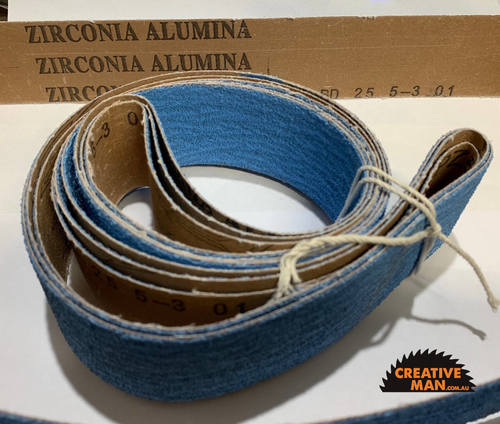Description
Abrasive Belts: What belts to buy?.
So here is a quick guide to get you going. This is not a long, exhaustive list covering lots of specialty-use belts for specialist makers, but a good middle-of-the-road list of belts that works well for us - and might work well for you.
The 10 second summary:
- For steel: 3M Cubitron II 767F belts - they are just better and cheaper than Ceramic belts.
- For steel: Ceramic belts - this was our favourite for many years. Lasts longer and grinds harder than the old Alu Oxide belts.
- For handles: Zirconia belts, less grit on the belt stops them clogging.
- For finishing: Aluminium oxide and/or J-Flex belts (up to say 400 grits)
- Optional: For satin grinder finish, consider cork belts, scotch bright belts or any of the 100 other types of "special finish" belts.

Why we recommend these belts:
Cubitron belts for steel:
- These are taking over for Ceramic belts due to grinding more even (less scratches) than the Ceramic belts, not needing to be run as hard to get a good life out of them. And even slightly cheaper. We really only use these at the Nordic Edge workshop for steel now. Sounds like a marketing spiel until the first time you try them and squint your eyes...where did all those sparks come from? These come in lots of different weights, mostly this is about how much abrasive is on the belt. We recommend 767F for knifemaking due to fitting well with abrasive to pressure ratio for hand grinding (holding the steel by hand against the belt) but also offer the heavier 984F belts for those wanting these.
Ceramic belts for steel:
- Ceramic belts last longer - and cost more - than your average hardware store belts. The belts are coated with small ceramic particles and these are HARD. The positive is that they cut for a long time, the negative is that to stay sharp they need to be used at FULL SPEED. If you turn the speed down for control, these are not the belts to use. So for profiling the blade, for cleaning up, and for bevel grinds: Go for ceramics. We sell36, 60 and 120 grits only, these are the only grits we use and that might work for you as well but there are even coarser grits available, and even finer but we then tend to turn the speed down and swap to J-flex belts. (update Oct 2023 - ceramic belts are good, we just find the Cubitrons to be even better)
Zirconia for handle materials:
- Zirconia: These last for a long time if used only for handle materials, and they excel at just that. They make short work of wood, micarta, antler, G10 and acrylics. We sell only 60 and 120 grits, just because these are the only grits we have found any use for when actually making knives.
- Zirconia belts are better at softer materials like handle materials due to not clogging as easily.
Alu Oxide belts for cleaning up:
- J-Flex are nice, soft belts for finishing the bevels and cleaning up the blade. They are great at overhanging the platen 5+ mm, creating a round edge to grind towards for blending lines, cleaning up the plunge line, etc. They also work great on the handle, removing coarser scratches from the Zirconia belts.
- Your standard hardware store belt, the Alu Oxide also work well, the J-flex are just a softer version and we tend to go for the J-flex to clean up.
Scotch brite belts for a satin grinder finish:
- If not going straight to hand-sanding, there are LOADS of options for fancy machine finish. The option we went with was a scoth bright belt type, kind of like a rough kitchen sponge. They clean up minor scratches and give a good machine finish. On forged blades they clean the blade up, while still leaving some forge scale behind for that nice, rustic look. They are expensive but seems to last for years and years.
What belts you will like to use might be different to what we use at Nordic Edge, and for many makers it changes over time. These are just our recommendation based on what we use ourselves in the workshops where we take students through making a knife in a day.
After having tried quite a few brands and hyped specialty finish belts, these are the 3 we reach for: Ceramics for steel, Zirconia for handle and some kind of finishing belt to smooth things out on the blade, and then using the slack belt for cleaning up the handle.
Is there a belt we missed that is something you would not want to be without? A new specialty-finish belt we should try? Let us know HERE












